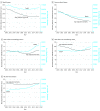Association Between Aging of the US Population and Heart Disease Mortality From 2011 to 2017
- PMID: 31663094
- PMCID: PMC6822092
- DOI: 10.1001/jamacardio.2019.4187
Association Between Aging of the US Population and Heart Disease Mortality From 2011 to 2017
Abstract
Importance: A deceleration in the rate of decrease of heart disease (HD) mortality between 2011 and 2014 has been reported. In the context of the rapid increase in the population of adults aged 65 years and older, extending the examination of HD mortality through 2017 has potentially important implications for public health and medical care.
Objective: To examine changes in the age-adjusted mortality rate and the number of deaths within subcategories of HD from 2011 to 2017 in conjunction with the change in the size of the US population during the same period.
Design, setting, and participants: In this quality improvement study, the Centers for Disease Control and Prevention Wide-Ranging Online Data for Epidemiologic Research (CDC WONDER) data set was used to identify national changes in the US population aged 65 years and older and in the age-adjusted mortality rates and number of deaths that were listed with an underlying cause of HD, coronary heart disease (CHD), heart failure, and other HDs from January 1, 2011, to December 31, 2017.
Main outcomes and measures: Changes from 2011 to 2017 in the US population and in age-adjusted mortality rates and number of deaths that were listed with an underlying cause of HD, CHD, heart failure (both as an underlying and a contributing cause), and other HDs overall, by sex and race/ethnicity.
Results: The total size of this population of US adults aged 65 years and older increased 22.9% from 41.4 million to 50.9 million between January 1, 2011, and December 31, 2017, while the population of adults younger than 65 years increased by only 1.7%. During this period, the age-adjusted mortality rate decreased 5.0% for HD and 14.9% for CHD while increasing 20.7% for heart failure and 8.4% for other HDs. The number of deaths increased 8.5% for HD, 38.0% for heart failure, and 23.4% for other HDs while decreasing 2.5% for CHD. A total of 80% of HD deaths occurred in the group of adults aged 65 years and older.
Conclusions and relevance: The substantial increase in the growth rate of the group of adults aged 65 years and older who have the highest risk of HD was associated with an increase in the number of HD deaths in this group despite a slowly declining HD mortality rate in the general population. With the number of adults aged 65 years and older projected to increase an additional 44% from 2017 to 2030, innovative and effective approaches to prevent and treat HD, particularly the substantially increasing rates of heart failure, are needed.
Conflict of interest statement
Figures
Comment in
-
Transthyretin Cardiac Amyloidosis in the Elderly-Tip of a Heart Failure Iceberg?JAMA Cardiol. 2021 Aug 1;6(8):979-980. doi: 10.1001/jamacardio.2020.4387. JAMA Cardiol. 2021. PMID: 34037661 No abstract available.
References
-
- Centers for Disease Control and Prevention, National Center for Health Statistics Underlying cause of death, 1999-2017. CDC WONDER [database online]. Atlanta, GA: Centers for Disease Control and Prevention; 2018. https://wonder.cdc.gov/ucd-icd10.html. Accessed April 4, 2019.
-
- Centers for Disease Control and Prevention, National Center for Health Statistics Multiple cause of death, 1999-2017. CDC WONDER [database online]. Atlanta, GA: Centers for Disease Control and Prevention; 2018. https://wonder.cdc.gov/mcd-icd10.html. Accessed August 8, 2019.
-
- US Census Bureau Projected age groups and sex composition of the population: main projections series for the United States, 2017-2060. Washington, DC: US Census Bureau, Population Division; 2018. https://www2.census.gov/programs-surveys/popproj/tables/2017/2017-summar.... Updated September 2018. Accessed April 4, 2019.
MeSH terms
LinkOut - more resources
Full Text Sources
Medical


